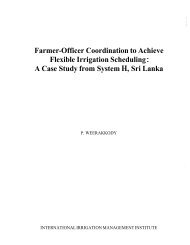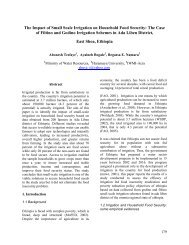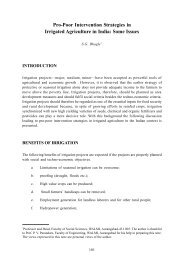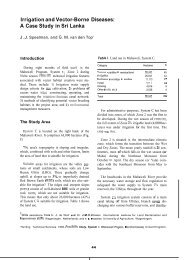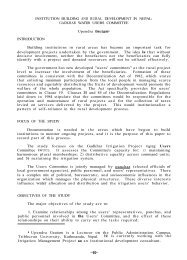WATER POVERTY IN THE NORTHEASTERN HILL REGION (INDIA)
WATER POVERTY IN THE NORTHEASTERN HILL REGION (INDIA)
WATER POVERTY IN THE NORTHEASTERN HILL REGION (INDIA)
You also want an ePaper? Increase the reach of your titles
YUMPU automatically turns print PDFs into web optimized ePapers that Google loves.
<strong>WATER</strong> <strong>POVERTY</strong> <strong>IN</strong> <strong>THE</strong> NOR<strong>THE</strong>ASTERN <strong>HILL</strong> <strong>REGION</strong> (<strong>IN</strong>DIA): POTENTIAL ALLEVIATION THROUGH MULTIPLE-USE <strong>WATER</strong> SYSTEMSGoswami, D.C. 2002. Flood forecasting in the Brahmaputra River, India: A case study. In. RegionalCooperation for Flood Disaster Mitigation in the Hindukush Himalayas, Chalise, S.R and Shreshtha,M. (Eds.), ICIMOD. Internal Report, 2002. pp. 40-48.Goswami, D.C.; Das, P.J. 2003. The Brahmaputra River, India: the eco-hydrological context of water usein one of world’s most unique river systems, Ecologist Asia (Special issue on Large dams in north-eastIndia: rivers, forests, people and power), 11(1): 9-14.Sharma, K.; Colavito, L. 2009. Experience of Multiple Use Water Services (MUS) Implementation inNepal. Paper presented at IWMI-NAIP Training Programme on Multiple Water Use Systems (MUS)in the Hilly Areas. Kathmandu, Nepal (March 3-5, 2009).Lawrence, P.; Meigh, J., Sullivan, C. 2002. The water poverty index: An international comparison. KeeleEconomics Research Paper 19. Keele, Staffordshire, UK: Department of Economics, Keele University.Mikhail, M.; Yoder, R. 2009. Multiple-Use water Service Implementation in Nepal and India: Experiencesand Lessons for Scale-Up. International Development Enterprises/ Challenge Program on Water andFood/ International Water Management Institute, Colombo, Sri Lanka. Pp. 345.Mishra, A. K.., Satapathy, K.K. 2003. Food security vis-à-vis natural resources sustainability innortheastern region of India. ENVIS Bulletin: Himalayan Ecology, 11 (1), G B Pant Institute ofHimalayan Environment and Development, Kosi-Katarmal, Almora, India. (available at: http://gbpihed.nic.in/envis/HTML/vol11_1/akmishra.htm)Pandey, N.D. 2009. Policy environment of Non-conventional Irrigation Technology in Nepal. Paperpresented at IWMI-NAIP Training Programme on Multiple Water Use Systems (MUS) in the HillyAreas, Kathmandu, Nepal (March 3-5, 2009).Pant, D.; Gautam, K.R. ; Shakya, S.D., Adhikary, D.L. 2006. Multiple Use Schemes: Benefit to theSmallholder. Working Paper 114, International Water Management Institute, Colombo, Sri LankaSamuel, M.P.; Satpathy, K.K. 2008. Concerted rainwater harvesting technologies suitable for hilly agroecosystemof Northeast India, Current Science, 95(9): 1130-1132.Sharma, U.C.1996. Yield sustainability and strategies in northeastern states. Productivity, 36:682-690.Sullivan, C.A. 2005. Method to develop and describe community level water poverty index scores. CEHWallingford, UK: Oxford University Centre for Water Research.v Koppen, B., Smit, S., Moriarty, P., Penning de Vries, F., Mikhail, M., Boelee, E. 2009. Climbing theWater Ladder: Multiple- use Water Services for Poverty Reduction. The Hague, The Netherlands,IRC International Water and Sanitation Centre and International Water Management Institute. (TPSeries No. 52). 213 p.42



